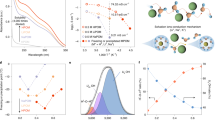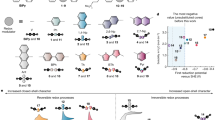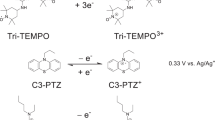Abstract
Aqueous organic redox flow batteries (AORFBs) hold promise for safe, sustainable and cost-effective grid energy storage. However, developing catholyte redox molecules with the desired stability, power and energy density remains challenging. In this study, we synthesized a class of ionic liquid-mimicking (2,2,6,6-tetramethylpiperidin-1-yl)oxyl dimers (i-TEMPODs) through a building-block assembly platform. By systematically investigating 21 i-TEMPOD derivatives, we uncovered the optimal size and charge properties that prevent membrane crossover and allow formation of a water-in-salt state. Leveraging these advances, we realized substantial improvements in AORFB performance using the optimum i-TEMPOD catholyte at 2 M concentration. These enhancements encompass several crucial metrics showcased across multiple experiments, including robust cycling stability without apparent capacity decay during 96 days of cycling, facile electrochemical kinetics with a high maximum power density of 0.325 W m−2 and a high full-cell energy density of 47.3 Wh l−1 in a capacity-balanced configuration. These molecular designs pave the way towards low-cost and scalable AORFBs.
This is a preview of subscription content, access via your institution
Access options
Access Nature and 54 other Nature Portfolio journals
Get Nature+, our best-value online-access subscription
$29.99 / 30 days
cancel any time
Subscribe to this journal
Receive 12 digital issues and online access to articles
$119.00 per year
only $9.92 per issue
Buy this article
- Purchase on Springer Link
- Instant access to full article PDF
Prices may be subject to local taxes which are calculated during checkout






Similar content being viewed by others
Data availability
The data that support the findings of this study are available in the paper and its Supplementary Information.
References
Sánchez-Díez, E. et al. Redox flow batteries: status and perspective towards sustainable stationary energy storage. J. Power Sources 481, 228804 (2021).
Wadia, C., Albertus, P. & Srinivasan, V. Resource constraints on the battery energy storage potential for grid and transportation applications. J. Power Sources 196, 1593–1598 (2011).
Winsberg, J., Hagemann, T., Janoschka, T., Hager, M. D. & Schubert, U. S. Redox-flow batteries: from metals to organic redox-active materials. Angew. Chem. Int. Ed. 56, 686–711 (2017).
Singh, V., Kim, S., Kang, J. & Byon, H. R. Aqueous organic redox flow batteries. Nano Res. 12, 1988–2001 (2019).
Luo, J., Hu, B., Hu, M., Zhao, Y. & Liu, T. L. Status and prospects of organic redox flow batteries toward sustainable energy storage. ACS Energy Lett. 4, 2220–2240 (2019).
Zhang, L., Feng, R., Wang, W. & Yu, G. Emerging chemistries and molecular designs for flow batteries. Nat. Rev. Chem. 6, 524–543 (2022).
Kwabi, D. G., Ji, Y. & Aziz, M. J. Electrolyte lifetime in aqueous organic redox flow batteries: a critical review. Chem. Rev. 120, 6467–6489 (2020).
Brushett, F. R., Aziz, M. J. & Rodby, K. E. On lifetime and cost of redox-active organics for aqueous flow batteries. ACS Energy Lett. 5, 879–884 (2020).
Huskinson, B. et al. A metal-free organic–inorganic aqueous flow battery. Nature 505, 195–198 (2014).
Lin, K. et al. Alkaline quinone flow battery. Science 349, 1529–1532 (2015).
Amini, K. et al. An extremely stable, highly soluble monosubstituted anthraquinone for aqueous redox flow batteries. Adv. Funct. Mater. 33, 2211338 (2023).
Jing, Y. et al. In situ electrochemical recomposition of decomposed redox-active species in aqueous organic flow batteries. Nat. Chem. 14, 1103–1109 (2022).
Huang, S. et al. Molecular engineering of dihydroxyanthraquinone-based electrolytes for high-capacity aqueous organic redox flow batteries. Nat. Commun. 13, 4746 (2022).
Liu, T., Wei, X., Nie, Z., Sprenkle, V. & Wang, W. A total organic aqueous redox flow battery employing a low cost and sustainable methyl viologen anolyte and 4-HO-TEMPO catholyte. Adv. Energy Mater. 6, 1501449 (2016).
DeBruler, C. et al. Designer two-electron storage viologen anolyte materials for neutral aqueous organic redox flow batteries. Chem 3, 961–978 (2017).
Beh, E. S. et al. A neutral pH aqueous organic–organometallic redox flow battery with extremely high capacity retention. ACS Energy Lett. 2, 639–644 (2017).
DeBruler, C., Hu, B., Moss, J., Luo, J. & Liu, T. L. A sulfonate-functionalized viologen enabling neutral cation exchange, aqueous organic redox flow batteries toward renewable energy storage. ACS Energy Lett. 3, 663–668 (2018).
Jin, S. et al. Near neutral pH redox flow battery with low permeability and long-lifetime phosphonated viologen active species. Adv. Energy Mater. 10, 2000100 (2020).
Lv, X. L. et al. Dextrosil-viologen: a robust and sustainable anolyte for aqueous organic redox flow batteries. ACS Energy Lett. 7, 2428–2434 (2022).
Sullivan, P. T. et al. Viologen hydrothermal synthesis and structure–property relationships for redox flow battery optimization. Preprint at ChemRxiv (2022).
Hollas, A. et al. A biomimetic high-capacity phenazine-based anolyte for aqueous organic redox flow batteries. Nat. Energy 3, 508–514 (2018).
Pang, S., Wang, X., Wang, P. & Ji, Y. Biomimetic amino acid functionalized phenazine flow batteries with long lifetime at near-neutral pH. Angew. Chem. Int. Ed. 60, 5289–5298 (2021).
Hu, B. et al. Improved radical stability of viologen anolytes in aqueous organic redox flow batteries. Chem. Commun. 54, 6871–6874 (2018).
Janoschka, T., Martin, N., Hager, M. D. & Schubert, U. S. An aqueous redox-flow battery with high capacity and power: the TEMPTMA/MV system. Angew. Chem. Int. Ed. 55, 14427–14430 (2016).
Nolte, O., Rohland, P., Ueberschaar, N., Hager, M. D. & Schubert, U. S. Stability of TMA-TEMPO-based aqueous electrolytes for redox-flow batteries. J. Power Sources 525, 230996 (2022).
Liu, B., Tang, C. W., Jiang, H., Jia, G. & Zhao, T. Carboxyl-functionalized TEMPO catholyte enabling high-cycling-stability and high-energy-density aqueous organic redox flow batteries. ACS Sustain. Chem. Eng. 9, 6258–6265 (2021).
Schubert, U. S. et al. Structural alterations on the TEMPO scaffold and their impact on the performance as active materials for redox flow batteries. Mater. Adv. 3, 4278–4288 (2022).
Pan, M. et al. Reversible redox chemistry in pyrrolidinium-based TEMPO radical and extended viologen for high-voltage and long-life aqueous redox flow batteries. Adv. Energy Mater. 12, 2103478 (2022).
Hu, B., Hu, M., Luo, J. & Liu, T. L. A stable, low permeable TEMPO catholyte for aqueous total organic redox flow batteries. Adv. Energy Mater. 12, 2102577 (2022).
Liu, Y. et al. A long-lifetime all-organic aqueous flow battery utilizing TMAP-TEMPO radical. Chem 5, 1861–1870 (2019).
Zhou, W. et al. Fundamental properties of TEMPO-based catholytes for aqueous redox flow batteries: effects of substituent groups and electrolytes on electrochemical properties, solubilities and battery performance. RSC Adv. 10, 21839–21844 (2020).
Ohira, A., Funaki, T., Ishida, E., Kim, J. D. & Sato, Y. Redox-flow battery operating in neutral and acidic environments with multielectron-transfer-type viologen molecular assembly. ACS Appl. Energy Mater. 3, 4377–4383 (2020).
Silva, W., Zanatta, M., Ferreira, A. S., Corvo, M. C. & Cabrita, E. J. Revisiting ionic liquid structure-property relationship: a critical analysis. Int. J. Mol. Sci. 21, 7745 (2020).
Hayes, R., Warr, G. G. & Atkin, R. Structure and nanostructure in ionic liquids. Chem. Rev. 115, 6357–6426 (2015).
Kühnel, R.-S., Reber, D. & Battaglia, C. Perspective—electrochemical stability of water-in-salt electrolytes. J. Electrochem. Soc. 167, 070544 (2020).
McEldrew, M., Goodwin, Z. A. H., Kornyshev, A. A. & Bazant, M. Z. Theory of the double layer in water-in-salt electrolytes. J. Phys. Chem. Lett. 9, 5840–5846 (2018).
Jaumaux, P. et al. Localized water-in-salt electrolyte for aqueous lithium-ion batteries. Angew. Chem. Int. Ed. 60, 19965–19973 (2021).
Martins, V. L. & Torresi, R. M. Water-in-salt electrolytes for high voltage aqueous electrochemical energy storage devices. Curr. Opin. Electrochem. 21, 62–68 (2020).
Perry, M. L., Rodby, K. E. & Brushett, F. R. Untapped potential: the need and opportunity for high-voltage aqueous redox flow batteries. ACS Energy Lett. 7, 659–667 (2022).
Zhang, M. et al. Understanding the microscopic structure of a ‘water-in-salt’ lithium ion battery electrolyte probed with ultrafast IR spectroscopy. J. Phys. Chem. C. 124, 8594–8604 (2020).
Mjalli, F. S., Naser, J., Jibril, B., Alizadeh, V. & Gano, Z. Tetrabutylammonium chloride based ionic liquid analogues and their physical properties. J. Chem. Eng. Data 59, 2242–2251 (2014).
Feng, R. et al. Reversible ketone hydrogenation and dehydrogenation for aqueous organic redox flow batteries. Science 372, 836–840 (2021).
Wu, M. et al. Extremely stable anthraquinone negolytes synthesized from common precursors. Chem 6, 1432–1442 (2020).
Goulet, M.-A. & Aziz, M. J. Flow battery molecular reactant stability determined by symmetric cell cycling methods. J. Electrochem. Soc. 165, A1466–A1477 (2018).
Luo, J. et al. Unprecedented capacity and stability of ammonium ferrocyanide catholyte in pH neutral aqueous redox flow batteries. Joule 3, 149–163 (2019).
Li, X. et al. Symmetry-breaking design of an organic iron complex catholyte for a long cyclability aqueous organic redox flow battery. Nat. Energy 6, 873–881 (2021).
Chen, Q. et al. Designer ferrocene catholyte for aqueous organic flow batteries. ChemSusChem 14, 1295–1301 (2021).
Li, W., Fu, H. C., Zhao, Y., He, J. H. & Jin, S. 14.1% efficient monolithically integrated solar flow battery. Chem 4, 2644–2657 (2018).
Acknowledgements
D.F. acknowledges start-up funds from the University of Wisconsin–Madison, the WARF Accelerator Project (AP) and the Draper Technology Innovation Fund (TIF). P.T.S. thanks the Vice Chancellor for Research and Graduate Education (VCRGE) for support. D.F., S.J., W.L., C.-J.C. and H.-C.F. thank UW–Madison WARF Accelerator for an electrification challenge grant. C.-J.C. thanks the National Science and Technology Council (NSTC) in Taiwan (109-2917-I-564-010) for a postdoctoral fellowship. R.J. and D.M. were supported by the Department of Energy (DOE; award no. DE-SC0020419). The authors thank I. Guzei for assistance with the collection of single-crystal X-ray diffraction data. The Bruker Quazar APEX2 was purchased by the UW–Madison Department of Chemistry with a portion of a generous gift from P. J. Bender and M. M. Bender. The Bruker AVANCE 400 NMR spectrometer was supported by the NSF (grant no. CHE-1048642). The purchase of the Thermo Q Exactive Plus mass spectrometer in 2015 was funded by the NIH (award no. 1S10 OD020022-1) to the Department of Chemistry. We also thank J. Berry and his student, J. Harris, in the UW–Madison Department of Chemistry for equipment and support in FTIR measurements.
Author information
Authors and Affiliations
Contributions
P.T.S. and X.-L.L. contributed equally to this work. D.F., W.L., P.T.S. and X.-L.L. conceived the work. D.F., W.L., S.J. and D.M. directed the experiments. X.-L.L. performed material synthesis and structure verification. H.-C.F. and C.-J.C. conducted the battery experiments. P.T.S. and X.-L.L. performed the physical, electrochemical and battery characterization. R.J. performed the AIMD simulations. All authors discussed and analysed the data. P.T.S., W.L. and D.F. wrote and revised the manuscript.
Corresponding authors
Ethics declarations
Competing interests
Wisconsin Alumni Research Foundation (WARF) has filed a US utility patent application (P210314US01) regarding the catholyte materials described in this paper with D.F., X.-L.L., P.T.S. and W.L. as inventors. D.F., X.-L.L., and P.T.S. have ownership stakes in Flux XII, which may profit from the results reported herein. The remaining authors declare no competing interests.
Peer review
Peer review information
Nature Energy thanks the anonymous reviewers for their contribution to the peer review of this work.
Additional information
Publisher’s note Springer Nature remains neutral with regard to jurisdictional claims in published maps and institutional affiliations.
Supplementary information
Supplementary Information
Supplementary Methods, Figs. 1–101 and Tables 1–14.
Rights and permissions
Springer Nature or its licensor (e.g. a society or other partner) holds exclusive rights to this article under a publishing agreement with the author(s) or other rightsholder(s); author self-archiving of the accepted manuscript version of this article is solely governed by the terms of such publishing agreement and applicable law.
About this article
Cite this article
Lv, XL., Sullivan, P.T., Li, W. et al. Modular dimerization of organic radicals for stable and dense flow battery catholyte. Nat Energy 8, 1109–1118 (2023). https://doi.org/10.1038/s41560-023-01320-w
Received:
Accepted:
Published:
Issue Date:
DOI: https://doi.org/10.1038/s41560-023-01320-w
This article is cited by
-
Catholytes that mimic ionic liquids
Nature Energy (2023)



